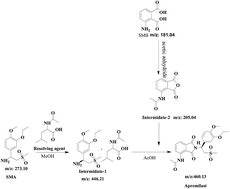Identification, characterization and HPLC quantification of impurities in apremilast†
Abstract
A sensitive, selective and stability indicating LC-UV method was developed for the determination of process-related impurities in apremilast. High performance liquid chromatography (HPLC) investigation of apremilast bulk samples revealed the presence of six impurities (Imp-A, Imp-B, Imp-C, Imp-D, Imp-E and Imp-F). Additionally, based on the characterization data, Imp-F is a new compound proposed to be N-{2′-[1-(3-ethoxy-4-methoxy-phenyl)-2-methanesulfonyl-ethyl]-1,3,1′,3′-tetraoxo-1,3,2′,3′-tetrahydro-1′H-[2,4′]biisoindolyl-4-yl}-acetamide. The structures of Imp-A and Imp-B were speculated based on LC-MS, UV and the synthetic process. The structures of the other four impurities were characterized and confirmed by IR, LC-MS and NMR techniques. The newly developed LC-UV method was validated by its satisfactory specificity, precision, accuracy and sensitivity. Quantitation limits for impurities were in the range of 0.795–1.498 ng. Correlation coefficient values of linearity were higher than 0.9985 for apremilast and four impurities. The mean recoveries of four impurities were between 92.5% and 103.2%. Thus, the developed HPLC method was suitable for the separation and quantification of all discovered impurities in apremilast at present. The possible mechanism for the formation of these impurities is also discussed.


 Please wait while we load your content...
Please wait while we load your content...